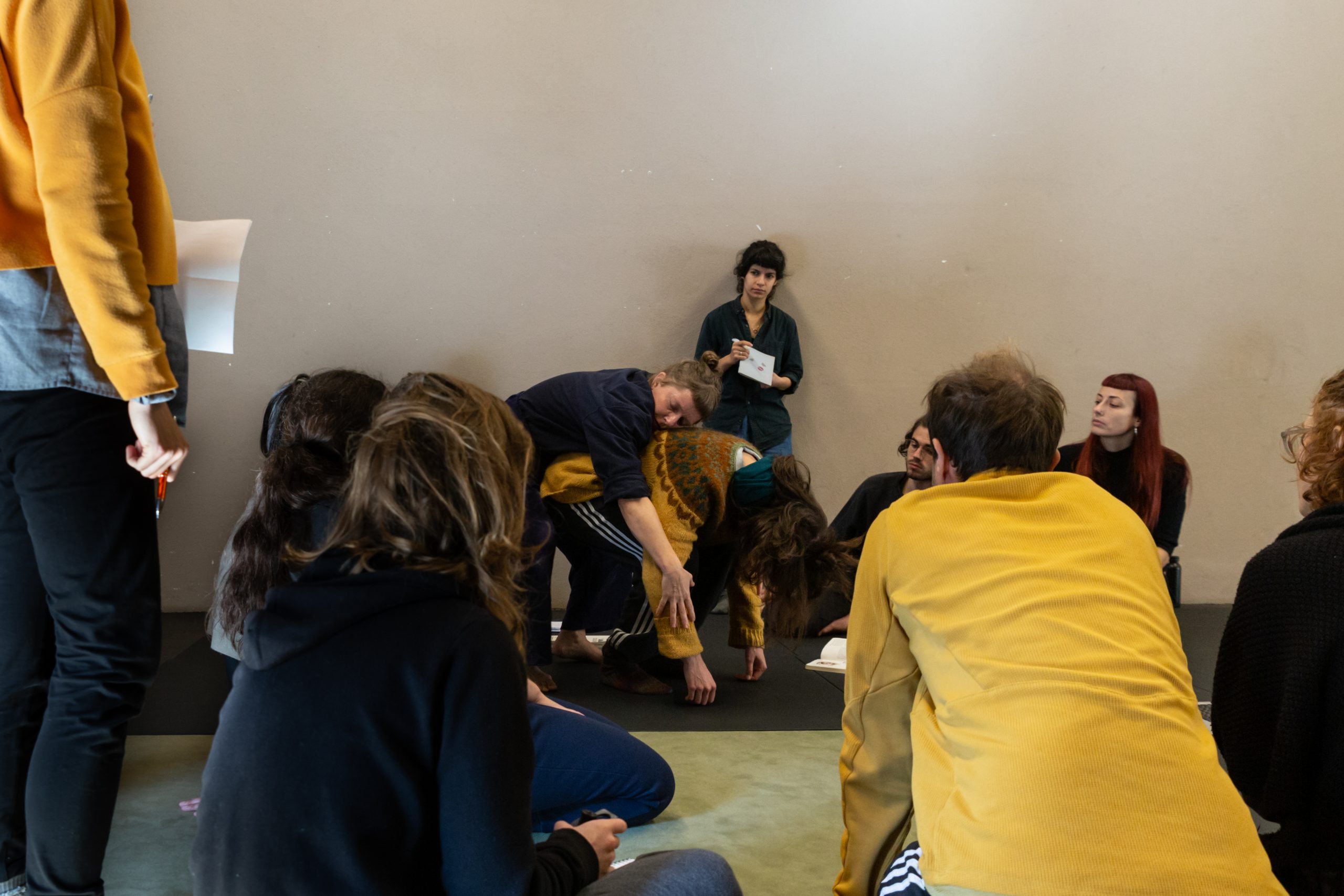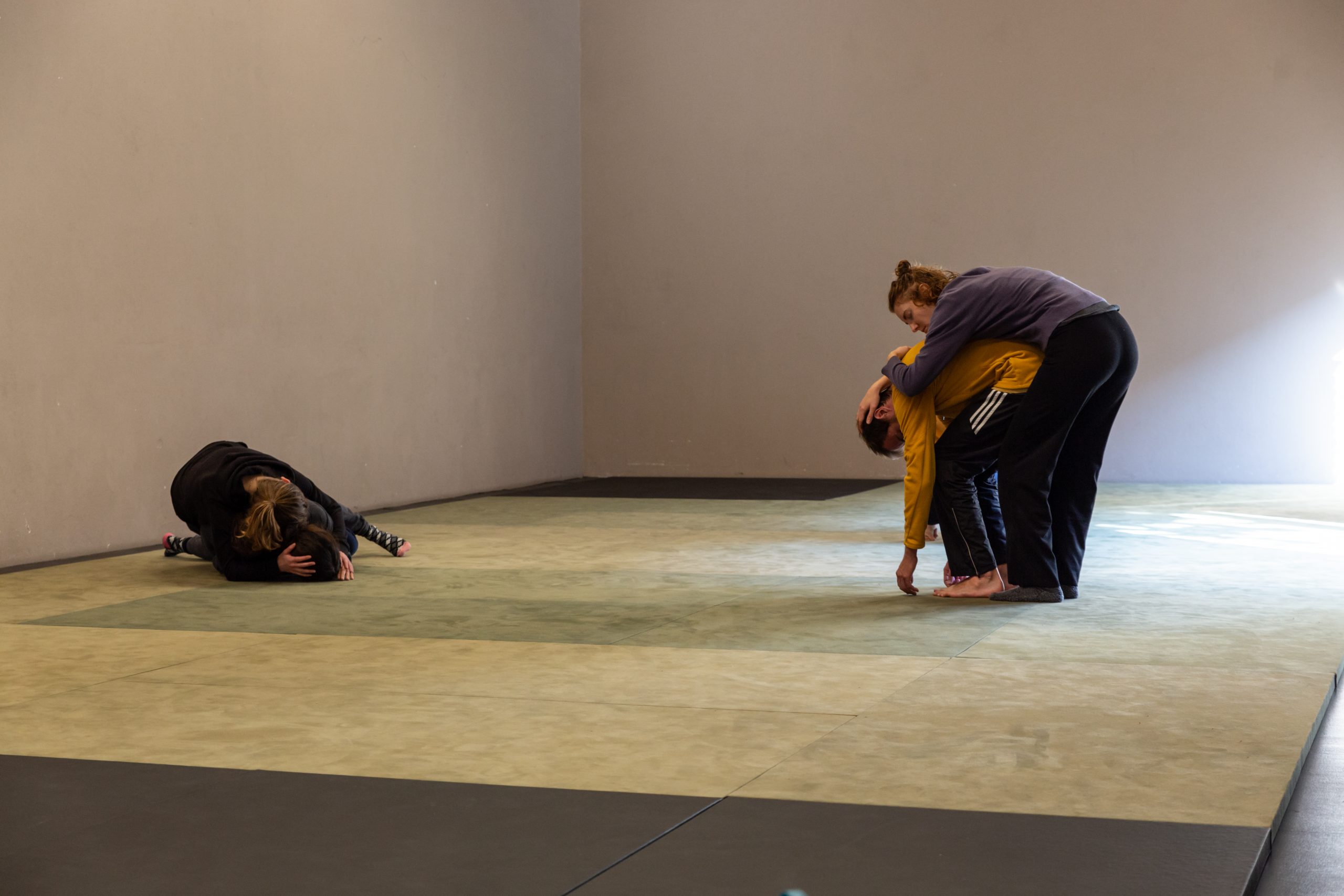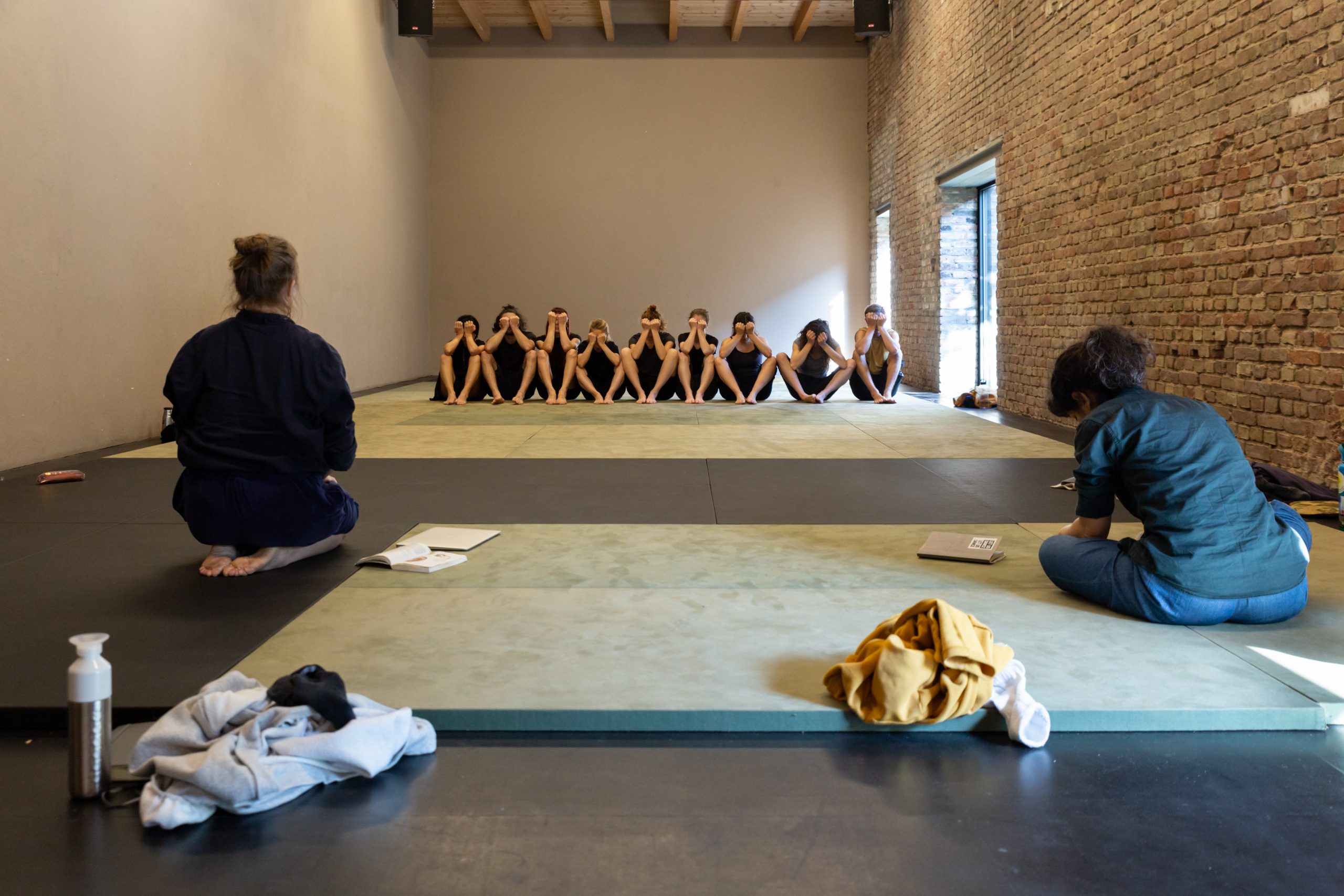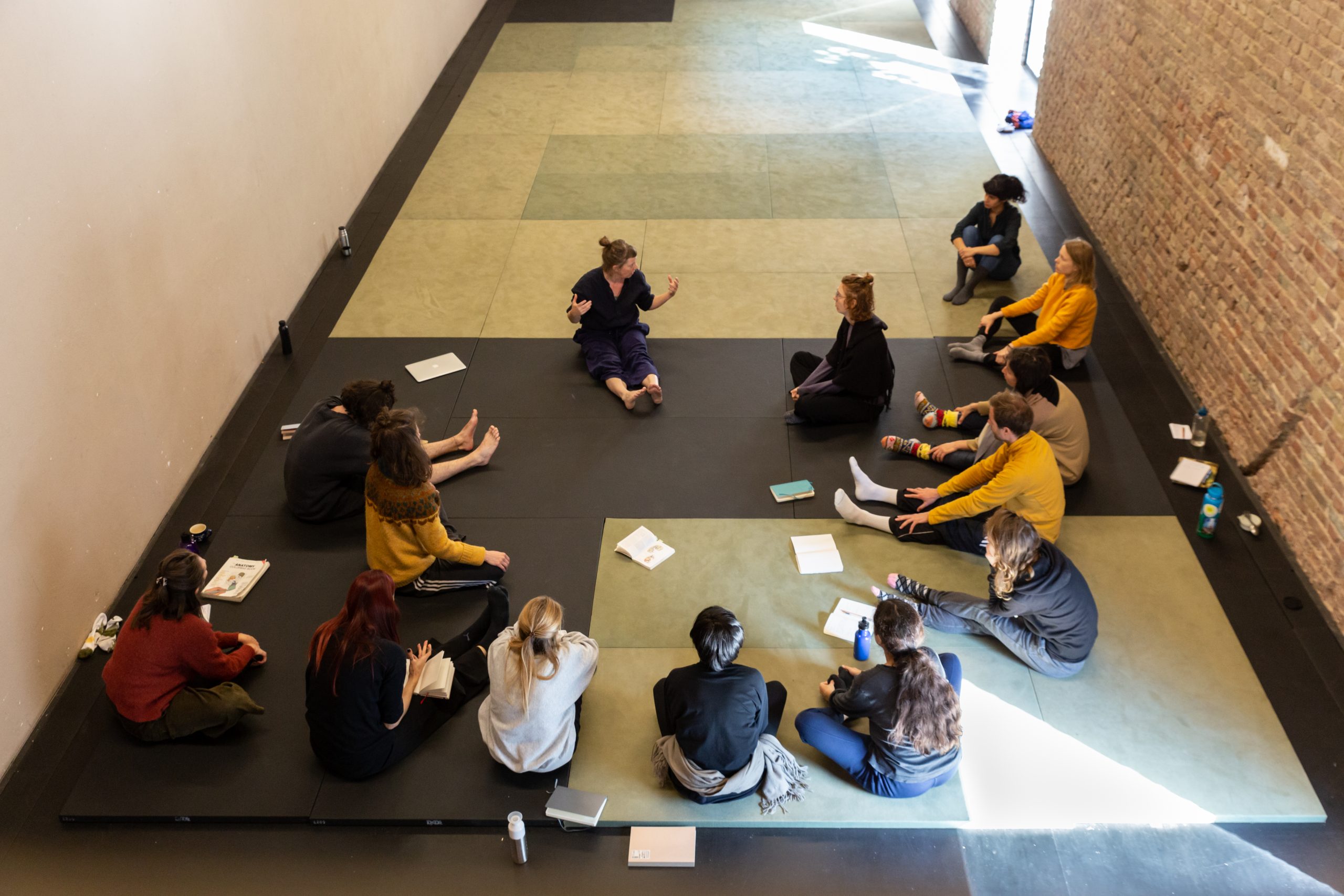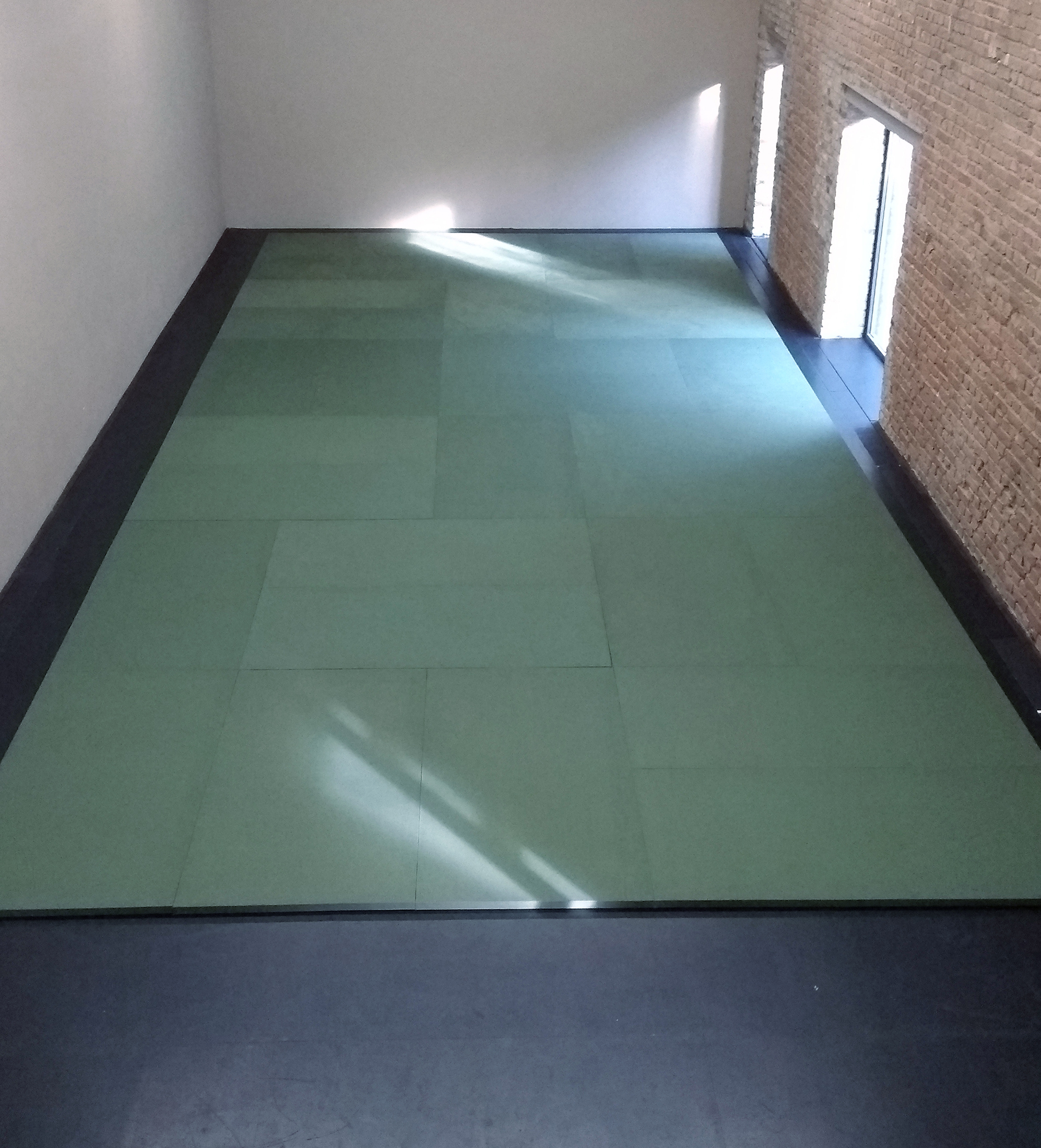Isabelle Schad is a German dancer and choreographer based in Berlin. I took a two-day workshop with her this week as part of the series called Somatic Charting hosted by Elena Basteri and The Institute for Endotic Research (TIER). The workshop was called, Perceiving the Whole. Propositions from a Practice, and took place from 10-14:00 on Friday and Saturday, the 8th & 9th of October, 2021. Isabelle shared key aspects of her choreographic practice influenced by a unique combination of Body Mind Centering (BMC), Aikido martial arts, Shiatsu energy work, European folk dances, as well as collaborations with the visual artist Laurent Goldring.
Both days we began with a warm-up on the floor connecting internally with the gravitational force. In this quiet space, the first sounds were the rubbing of hands and sliding them across the floor. Throughout the warm-up she intertwined anatomical and cellular language from her BMC training. In one Aikido exercise, we practiced shifting weight along an axis. Step, shift, step – a simple turning movement guiding us slowly across the floor as if “testing the ice” with every step. To move along the axis smoothly, Isabelle intervened with a partner exercise to activate “the cellular layer”. We took turns awakening the front and back spaces of each body via touch and then silently standing behind the other while facing the same direction to energetically protect the nervous system. With this added layer of awareness, we danced along the axis once again – this time in sync with our partner and slowly shifting axes to move throughout the entire space. This combination of energetic and cellular modes of perception provided additional support in perceiving our bodies within the whole.
In an interview with Isabelle after the workshop, I asked: What is this “whole” for you? She responded, “It’s about seeing the body holistically, the space, the group, and even the universe! It’s hard to sense yourself as just bones or cellular tissue, sometimes you just feel like your-self!“ Thus, it’s about more than the sum of individual parts. Her practice is about trying to sense togetherness and the wholeness of that experience. A lot of the exercises around touch came from Isabelle’s work with the Shiatsu healing method. When we provided each other with touch exercises, she reminded us that, “Giving and receiving can be perceived simultaneously.” Over time, Elena Basteri (Dramaturg for Isabelle) explained, this training can enhance the “somatic perception” of dancers. In fact, it highlights the role that the other plays in perceiving the self. We sense ourselves through being in relationship with others. This kind of reciprocity is essential to being able to perceive the whole.
In the workshop, Isabelle explained: “In those moments, somatics became problematic for me when it became somewhat insular – where is the perceiving of the whole?” After spending ten years immersed in BMC somatic practices looking inward, she craved to create a form where the anatomical processes could also be seen visually from the outside. For example, together with Laurent Goldring, she began to ask: “How can I amplify the process that happened in the uterus?” Drawing from the embryological understandings she gained through her BMC training, she began to create choreographic scores that would make processes such as the developing stages of an embryo visible to the viewer.
The somatic practices that Isabelle chose to share with us were intended to support us, bring relaxation so that we could nourish each other. This year throughout the pandemic, she led trainings in Humboldthain Park – she said, “Just for the sake of training.” In a similar way, the workshop was about feeling togetherness for the sake of togetherness, learning along the way how to perceive oneself as part of the whole. In the second half of the workshop, we brought this feeling of togetherness into choreographic explorations meant to amplify anatomical processes so that they can be perceived aesthetically by a viewer. What kinds of forms emerge from and can illuminate this space of togetherness?
Drawing from previous works, Isabelle chose specific scores to play with. One such score, she calls the “double body”. She gave a short embryology lesson, explaining how all organs of the human body emerge from the front and back space of the embryo. It’s important to learn that the nervous system develops from the back layer and the internal organs from the front space. To map this process choreographically, Isabelle positioned two bodies nestled next to each other – one as the front layer and one as the back. Like the embryo, the score is that they fold together into a fetus position on the floor and then slowly ‘grow’ outward from this enveloped cell to a body with organs and limbs. Not only is it a nourishing experience for the dancers, intimately connected to another body – but it’s also a powerful image of two bodies becoming one.
On the second day, we worked on our backs on the floor with legs, feet and shoulders in the air with skin exposed. Isabelle asked us to hold our feet covering toes with our hands while intertwining our legs so that the opposite knee would meet each shoulder. From a distance, this angle completely warps the composition of the body, transforming its shape into something unrecognizable. When several of these bodies are lined up next to each other, it begins to take on an organic shape – perhaps some sort of spine, a skin-like caterpillar, or even a vibrating DNA strand. It’s comical, yet also biological. While making this piece, Isabelle mentioned that she was also working on a project about folk dances in Europe. The flow and homogeneity of these folk dances inspired the way she imagined these bodies beginning to meld together into a larger body. However, she noticed that the folk dances she worked with did not have much variation, since they were orchestrated from rules that demanded unison. Instead, she wanted each body to become a piece of the larger whole in a way that allows for random variation, perhaps how cells multiply and play as they vibrate against and around each other. This adds more dynamic qualities to the movement, creating a sense of infinite emergence and makes political statements about what constitutes togetherness and belonging.
We ended each day with 30 minutes of Aikido sword training, “just for the sake of training”. We moved together, shifting weight, developing a relationship with the sword as an extension of the body, sensing the motion of the wooden sword moving through the air. We used our newly trained senses to navigate the space around us, moving as one whole self together with the sword, together with the group, finding a kind of dynamic flow of the universe within each of us.
Sophie Schultze-Allen (they/she) is a dance researcher and embodied climate justice facilitator based in Berlin.
